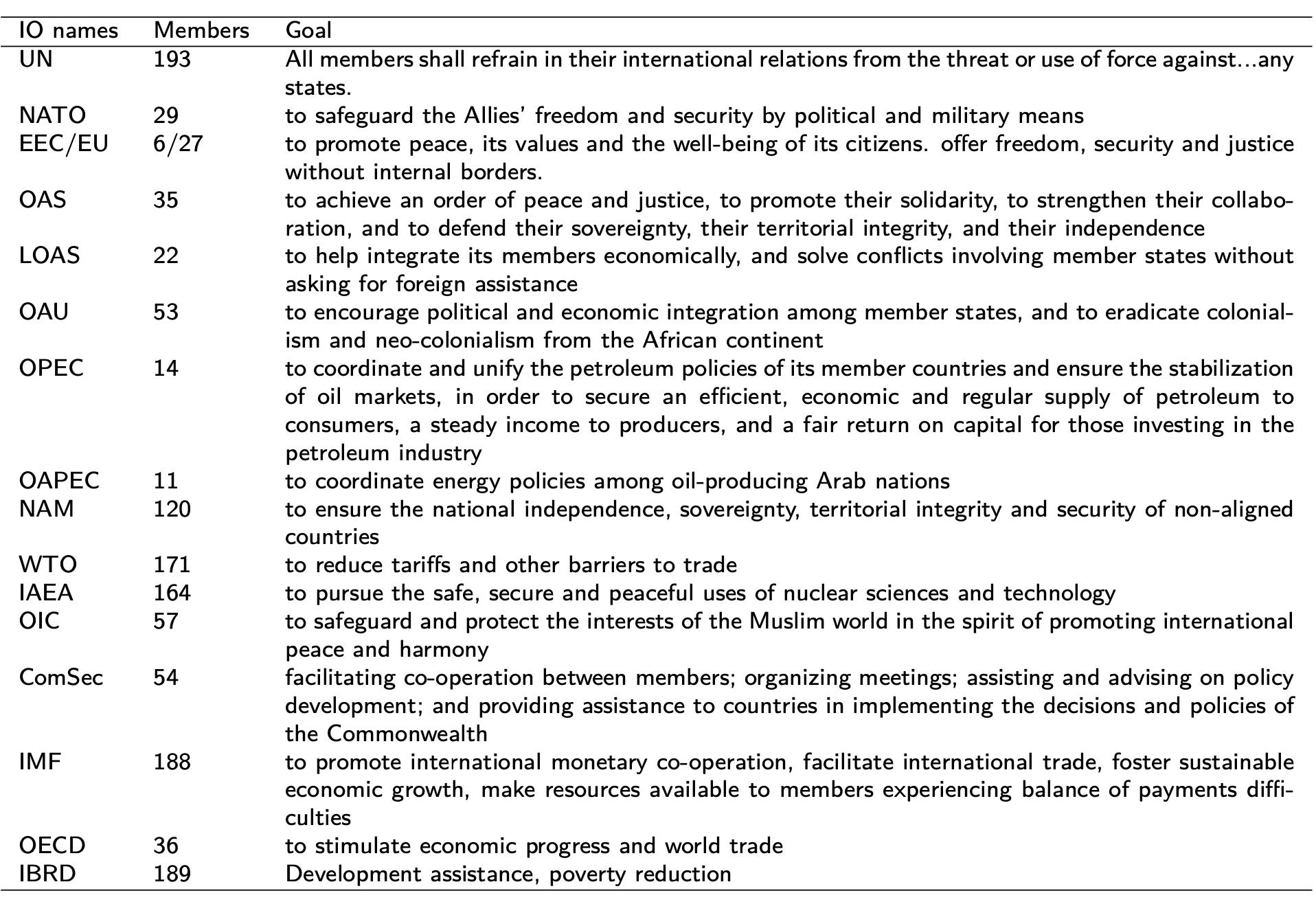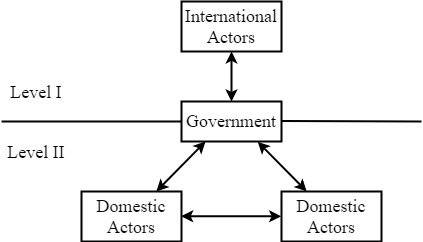Chapter 3 International Organizations

3.1 How to study IO
1. state sovereignty and legal obligation
2. Commitments, compliance, and enforcement
3. UN, WTO, IMF, WB, EU, ICJ, ICC, ILO, OAS, AU, ASEA
3.2 Key terms need to know
State sovereignty is defined by the legal and normative framework that constitutes states as the final authority over their territory and the people within it.
Non-intervention: when it comes to military invasion from the outside. Consent: states are free to withhold or to withdraw their consent to the rules as they see fit.
Effectiveness: whether IOs contribute to desirable outcomes?
Global governance: the broad range of rules and actors that make up the international regime on an issue.
IO: focuses on particular rules that define or issue from a specific legal body.
3.3 Roles of International Organizations
Most international conflicts are not settled by military force. Despite anarchic nature of international system based on state sovereignty, the security dilemma does not usually lead to a breakdown in basic operation among states.
States generally refrain from invading and conquering each other.
States work together by following rules they develop to govern their interactions, because of self-interest.
Institutions grow up around rules and states tend to work through these institutions.
3.4 International norms
Rules that govern most interactions in IR are norms;
International norms are the expectations held by state leaders
about normal international relations;
Sovereignty and respect for treaties are widely held Agreed norms of behavior3.4.1 International norms conflict
Power of international norms and standards vary when states hold different expectations of what is normal
When shared norms and habits may not suffice to
However, adherence to norms may vary; different expectations for “normal”
In times of change, when these norms and habits may not suffice to solve international dilemmas and resolve conflict, institutions play a key role.
3.5 IOs
International Organizations: clusters of ideas and coalitions of interest at a transnational level that generate purposeful activities in pursuit of a desired outcome
Operate at a level above individual states; but this does not mean they are more powerful than states.
3.5.1 Two types of IOs
Include intergovernmental organizations (IGOs) such as the UN - set up by states through multilateral agreements, and nongovernmental organizations (NGOs) such as the International Committee of the Red Cross - set up by non-state or non-government actors
Regional IGOs - EU, NATO, African Union, Arab League
Global IGOs - UN, G20
NGOs - more specialized in function than IGOs
3.6 IO theories
IO theories: Realist, liberal, Marxist, and Constructivist approaches
Single-IO studies vs. large-N quantitative investigations
3.6.1 What drives IO formation?
Functionalism: minimize nationalism and attachment to territory, which had for centuries served as the basis for political conflict (in order to facilitate citizen interaction on a large scale). Either top-down or bottom-up process Its basic premise is that states create IOs to solve cooperation problems that cannot be resolved as well unilaterally or via decentralized solutions.
Neofunctionalism (1960s-1970s): organizations grew from efforts to overcome political conflicts through the integration of technical tasks. (with the emergence of the International Atomic Energy Agency, the World Health Organization, and the UN Commission on Trade and Development)
A rise to a new generation of studies of how and why IOs formed: failures of regional integration and European difficulties in deepening integration.
3.6.2 Theories
Systematic level of analysis:
Realist-oriented: hegemony Strong states were needed to create international cooperation. In the absence of those strong states, international cooperation and the organizations that guided that cooperation would inevitably decline (borrowed from Charles Kindleberger)
Hegemony Stability Theory (HST): the hegemon created regimes and organizations to facilitate leadership. In this model, hegemons created the supply of IOs which smaller states would subscribe to, and in this way hegemons could make their rule more efficient, thus saving resources to forestall their inevitable decline.
Constructivism: reject the claim that state interests exist prior to social interaction; rather interest and identity are a product of social interaction.
Marxist (Robert Cox): the IOs created by the victors of the social conflicts of the nineteenth century abet strong states’ rule over other states in the international system.
Ikenberry: strong states create international institutions to bind themselves, signaling “strategic restraint” to reduce fear in smaller states.
Regime theory: regimes are not designed by states to solve a particular problem at hand, but rather emerged as “rules, norms, principles, and decision-making procedures” that would create or focus expectations about behavior.
Neoliberal institutionalism-After Hegemony (Robert Keohane):
- HST only explained the supply of IOs and regimes, and even then, did so inadequately when one examined varying issue areas.
- HST could not explain why regimes were more abundant (and growing) at a time when the global hegemon was waning.
- Theories of transaction cost economics and neofuntionalism: States create institutions because they have common interests in cooperation to achieve mutual gains. (explanation: states are rational egoists; they cannot achieve these gains without institutions to guide cooperation. Thus, there is a demand for regimes that allows states to achieve gains that they otherwise could not.
Domestic politics 1. Two-level games (Putnam): How domestic preferences could drive states to form IOs for domestic reasons rather than primarily for internationally driven reasons. Moravcsik: IO’s can help certain types of states solve domestic credible commitment problems. Joining IOs can be driven by the need for states to credibly commit to particular policies domestically. IO’s serve to help leaders commit to policies favored by particular domestic coalitions of actors.

Two level games: A theory that explain the international relations between national and international level during international negotiations. National level: national political leaders; domestic groups, political party coalitions, and parliament International level: diplomats, international advisors
Level1: chief negotiator bargain with other negotiators, leading to a tentative agreement
Level 2: separate discussions within each group of constituents about whether to ratify the agreement
3.6.3 Deciding which to join?
Power-based perspective: Strong states can unilaterally change the status quo, with or without the assistance or approval of weaker states. Thus, the latter must join IOs so as not to be left behind by the march of international cooperation.
When IO’s expand
Domestic politics
Information-providing functions of IOs;
IOs provide legitimacy for proposed policies due to the nature of their operations;
State leaders need a viable mechanism to signal their competence in economic matters to their electorate (Mansfield, Milner, and Rosendorff);
Changes in domestic political institutions - newly democratized states are more willing to join human rights institutions than are long-standing democracies or authoritarian states (Hafner-Burton, Mansfield, and Pevehouse);
Forum-shopping: states will choose the forum that not only will result in an outcome most favorable to them, but also will set the most significant precedent, so that states can use similar strategies in the future with regard to other members of the agreement.
3.6.4 Operating IOs
Bureaucratic politics Bureaucrats can transform their own institutions apart from state interests. Relatively few IR scholars have used organizational theory to understand the functioning of IOs.
Intergovernmentalism IO operation hinges strongly on cooperation from member state governments—or “obstinate” nation-states—which can obstruct cooperation by pursuing their national interests. Regional hegemons can also facilitate institutional operations by solving coordination problems.
NGOs NGOs can attempt to influence the politics of IOs in a variety of ways. One is through an information mechanism whereby IO bureaucrats (and potential states) are informed of citizens’ preferences through NGOs. IOs themselves may tap NGOs for information and expertise as well, especially in particular issue areas or to help with monitoring. Another mechanism whereby NGOs can change outcomes is through influencing the design of IOs or their emanations.
3.6.5 Outcomes
Domestic politics
International security and trade
Side-effects:
Positive: the role of preferential trade agreements in enforcing human rights, judicial activism in international courts, and UN security council membership’s indirect effect on aid flows;
Negative: the effect of WB and IMF structural adjustment programs on human rights and civil strife, the effect of IO election monitoring on governance and risks of violence, the effect of peacekeeping on both violence and sex tourism; and the effect of the WTO’s dispute settlement mechanism on the success of developing countries in the settlement process.